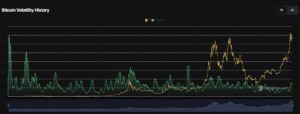Over the past 30 days, Bitcoin’s price has been changing by about 4%, which is a lot less than the nearly 18% it was changing by back in April 2013. This means Bitcoin’s value is becoming more stable, similar to regular stocks.
With the Bitcoin halving just weeks away and ETF excitement speeding up its arrival, everyone’s buzzing about it. But as the event draws near, the market is changing, meaning we need new trading strategies.
Bitcoin Halving and Changing Market Dynamics
During the past three cycles, Bitcoin halving events have been characterized by significant spikes in volatility. Typically, a 30%-40% sell-off would precede a rapid ascent to a new all-time high within an average of 480 days after the halving. However, the introduction of the spot Bitcoin ETF has altered this pattern.
To forecast Bitcoin’s future price movements, it’s crucial to analyze its volatility. Despite the anticipation surrounding the halving, recent months have seen relatively mild drawdowns compared to previous cycles. Corrections have been limited to under 25%, with the latest drop reaching just 15% before Bitcoin surged back towards the $70,000 mark.
The subdued sell-off signals a potentially less dramatic rally post-halving. While Bitcoin is expected to experience the customary post-halving sell-off and subsequent new all-time highs, the magnitude of price increases may not match the over 600% gains witnessed after the 2020 halving.

Source: Glassnode
Two primary factors are driving these shifts. Firstly, the percentage of long-term Bitcoin holders has surged to a record high, with over 70% of the total circulating supply held by long-term investors. Additionally, the introduction of the spot Bitcoin ETF has significantly altered market dynamics. These ETFs are absorbing more BTC supply than miners can generate, exacerbating scarcity and fueling upward price momentum.
Bitcoin ETFs Changing Long-Term Volatility
With the emergence of Bitcoin ETFs, there’s a noticeable shift towards reduced long-term volatility, primarily driven by the long-term mindset of ETF investors. Despite a recent uptick in volatility leading up to the halving event, levels remain significantly lower compared to previous halvings. CoinGlass data indicates a decline in 30-day historical BTC/USD volatility from nearly 18% in April 2013 to approximately 4% currently, resembling figures typically seen in traditional equity fund fact sheets.

Bitcoin price (yellow) versus Bitcoin volatility (green), April 2013 through April 2024. Source: CoinGlass
Investors entering spot Bitcoin ETFs are akin to those participating in S&P 500 ETFs, with a focus on long-term investment horizons and considerations of macroeconomic conditions and market structural changes. Consequently, their investment decisions are guided by long-term drivers rather than short-term fluctuations.
Investors seeking to capitalize on the halving must adopt a more traditional equity investor mindset, shifting their focus from crypto-centric metrics to tools like Morningstar for evaluating spot Bitcoin ETF assets under management. Monitoring the behavior of long-term holders becomes paramount, as they now wield significant influence over market direction.
While the days of 600% returns post-halving may be behind us, investors can anticipate steadier and more reliable returns, aligning better with the risk profiles of balanced portfolios. This trade-off offers a more appealing prospect for most investors compared to the volatile nature of speculative assets.
Important: Please note that this article is only meant to provide information and should not be taken as legal, tax, investment, financial, or any other type of advice.
Join Cryptos Headlines Community
Follow Cryptos Headlines on Google News











